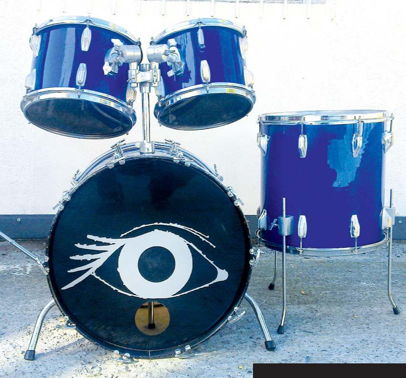Polish drumming history (meaning: in bands playing popular music) is fairly short. Something that had been cultivated and cherished in the West by schools, churches and the military was basically non-existent in Poland under communist rule. More than four decades of shoving Soviet artists down our throats, anti-western propaganda plus censorship effectively discouraged many independent artists.

The pioneers of modern popular music in Poland were the 20th century trubadours, i. e. bands that would play under tenement house windows in the 1920s, 1930s and during WWII. They would brighten the existence and hardships in those difficult times. After the war, as the country was slowly risen from ruins, that type of making music died out and is now present only as folklore.
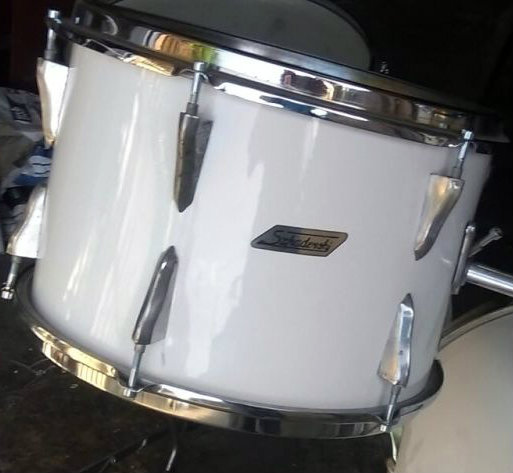
The early post-war years, especially up until 1950, saw the first attempts to form jazz bands. The communist government didn’t like their citizens playing “imperialist music” and did absolutely everything they could to prevent that from happening or at least make it very difficult. Drummers literally had to make cymbals from silver cake stands and trays.
In the 1960s, the government’s policy became more lax and rock and roll bands started appearing in every town and village. This created immense demand for musical instruments, mostly drums and guitars. As the contact an average Polish citizen had with western countries was very limited, there was an increasing demand for domestic manufacturers to start operating.

The most seminal figure amongst Polish drum manufacturers is and will always remain the late Mr. Zygmunt Szpaderski. He was an engaging and charming man, whose venture made it possible for countless drummers not only to start their careers, but actually have them for years. Production of Szpaderski drums commenced in the 1950s and lasted for over 40 years.
It is difficult to describe the first kits made at Mr. Szpaderski’s shop in Lodz, Poland as very few have survived in a condition allowing for identification. I remember the fact that older Szpaderski kits featured slightly more shallow toms with diameters starting from 12” (smaller ones were not made), a 20-inch bass drum (with metal rims, same ones on toms as well), and narrow, long lugs, which showed resemblance to old Premier lug design. The toms on those older kits were mounted to the bass drum with the help of rather thin holders (separate for each tom) which penetrated the bass drum shell. Bass drum legs were thin and did not extend. The plywood Mr. Z used at the time was certainly alder and birch. The hardware was light and thin. The stands were supposed to hold the cymbals and do nothing more. They did so, by the way. The heads were still actual animal skins at the time.

The classic Szpaderski kits from later years were typically rock drums. They were big, heavy and deep (this applies to rack and floor toms). The bass drums were relatively shallow as their maximum depth was 16 inches. The plywood Mr. Z used he himself divided into two categories: deciduous and coniferous. We can only guess it was alder, beech and birch (the former category) and pine (the latter). The shells were rather thick and could have been equipped with enforcement rings depending on the availability of materials or the maker’s mood. Unfortunately, the plywood was not of the highest quality. There were gnarls, cracks and delamination would also occur, however, the producer had no influence on that. So many years on, it is impossible to say if the material had been seasoned and prepared for drum production rather than furniture production.
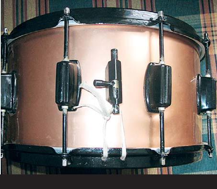
In time, the tom mounting system was significantly improved with the introduction of two powerful, sprocket holders while bass drum legs had turned into very thick shafts (Rogers-like).
I think all Polish drums from that era (Szpaderski, Polmuz, Słowik) featured wrap finishes. Sadly, I have never come across a factory-painted drum made in communist Poland. The only exception is Mr. Jurczuk, who did put lacquer on the snares he made.
The wrap itself and the way it was put on by Mr. Szpaderski deserve looking into as well. The shells were not directly covered with the wrap. First, Mr. Z would put a sheet of thin wood-like wallpaper (really!) to be covered by transparent laminate, which was glued to the wallpaper. The glue would react with the laminate, which created a hard wrap on a shell.
All the manufacturing activities relating to wood, such as plywood steeping, plywood forming, drying, drilling holes etc. were performed by Mr. Szpaderski himself at his shop in 86 Piotrkowska St. in Łódź, Poland. In the heyday of his business, when people would literally queue in front of the shop to buy his drums, Szpaderski was able to assemble two kits a day by himself. Considering the production process was fully manual, this is an amazing result. However, in the 1970s, it still meant that a customer had to wait for a full drum kit from Szpaderski for quite a long time (up to two months).
The situation with the hardware was very much the same. Lugs, rims, tuning rods, snare strainers, snares – all that was made by Mr. Z’s capable hands. These days, it’s impossible to imagine 100-per-cent hand made subassemblies of a drum kit, which was later sold at a price affordable to most people. His cymbal stands from the era were virtually bullet-proof and are still used, also by professional drummers. The hardware design was a bit similar to Ludwig, Slingerland and other big drum companies of the day.

Many are not aware of the fact that Mr. Szpaderski’s custom shop also produced effect cymbals. The man manufactured pretty good chinas. They were most probably made from brass and hand-hammered on a hard place somewhere. They looked and sounded similar to Chinese Wuhans. At first, the company offered larger sizes (especially 18″). Later on, 14″ and 12″ sold very well (not as commonplace as they are today). Until very recently, we had a piece of a Chinese cymbal like that…
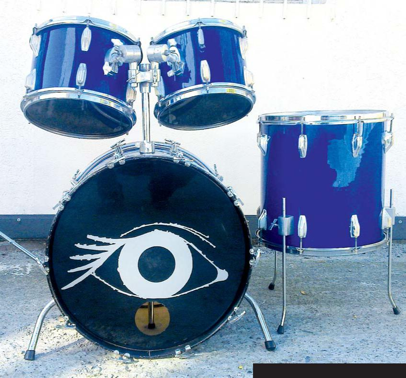
A proverbial situation happened when sports shops in the city of Łódź ran out of table tennis plastic balls when Mr. Z started experimenting with his own drum head production…
Having analyzed Szpaderski‘s products from the later years of operation, I can safely say he adapted a number of solutions applied by renowned international companies such as Ludwig, Premier or Sonor. Despite his advanced age, Zygmunt Szpaderski followed all the latest developments in the world of drum equipment and would keenly dig deep into catalogues from the biggest drum companies.

Today, many drummers regard Szpaderski drums a dog merely good for garage punk band rehearsals and squat gigs. After the fall of communism, the development of production and imports into Poland have resulted in these drums with a true soul costing the equivalent of the amount one will part with on a Friday evening visiting a lowly dance club. In all honesty, it shouldn’t come as a surprise because these handmade instruments and hardware have not stood the test of time and do not arouse the attention it used to. What we need to remember, though, is that it was Mr. Szpaderski and his drums that helped keep the art of drumming alive in Poland in the dark night of communist rule.
Polish auction sites offer about a dozen old Polish kits and snares daily. However, most of them can only be used for making a bone fire at a music video shoot or playing the Keith-Moon-at-the-end-of-a-gig game. Well-preserved Szpaderski snare drums will always find a new owner, let alone those really interesting models.

The most widely known “specimen” is the wood 14”x8” shell. It came in different outer finishes (I have come across a few made from dark , cherry-tree-like plywood), with double lugs I remember very well, which were made from plastic covered with silver varnish. Sadly, the varnish would peel and come off after some time. This snare drum had two characteristics. The first one being a fairly complicated double strainer, which was best not to dismount as it was really hard to put back together afterwards (believe me, I’ve tried). It also did not always function properly. The other characteristic was the drum’s sound, which was not bad at all, even with Szpaderski skins (the company only offered smooth ones, without the rough coating). There is quite a number of drummers who play these snares to this day. Because of the material they were built from (usually birch), this model was saught after among “heavy wight players”. It was also the only snare drum of this size available in Poland, and we all know heavy metal drummers love anything that’s heavy and big.
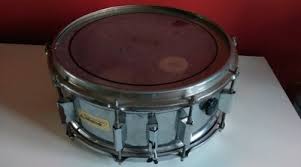
A slightly less known model (one I remember vividly) is a 14”x5” steel shell snare. The throw-off mechanism was simply a lever while the characteristic lugs were rectangle-shaped. The shell was made of standard steel and had two lines around and a classic-looking metal ‘Szpaderski” badge. To this day, one encounters these snares in many rehearsal spaces all over Poland. Judging by the condition today, this model was high quality as it is not eaten away by rust, even now. The interesting thing is that the shell must have been chrome-plated in a slightly different way than the lugs as the latter are much more susceptible to rust and blight.
Most snares and bass drums that came out of Mr. Szpaderski‘s shop had 10 tuning rods on each side, while rack toms and floor toms were fitted with 6 and 8 respectively. The kits made just before Mr. Z’s passing were very solid and the hardware was heavy, massive and sturdy.
It should also be noted that, aside from standard products, Mr. Szpaderski also made custom drums. Anybody who felt like having a deeper kick drum or a shallower tom could consult the Master and patiently wait for his or her dream kit. A good example of that is the beautiful 12”x5″ snare made for my business partner at Avant Drum Shop within 5 hours.
The life and work of Zygmunt Szpaderski could be an inspiration for writing a thick book rather than a short article. The man who can easily be called the father of Polish drummers in the period between the late 1940s and 1990s is always remembered fondly and with affection. I think every conscious drummer in Poland has a certain amount of respect and admiration for this humble, modest and joyful man. I also think Mr. Z still follows the world of drums from up above.
I dedicate this article to Mr. Zygmunt Szpaderski on behalf of all the drummers for whom his shop was the only hope for fulfilling their musical dreams in communist times.
Mateusz Wysocki
Photo: Mateusz Wysocki and unknown Internet users.
Mateusz Wysocki is known to many Drummers and Drummerettes in Poland from his work at the Avant Drum Shop (based in Poznań, Poland). He is also an active drummer, currently touring and recording with the band Neons of 101, as well as a lover of all things vintage as far as drum kits, snare drums and hardware are concerned.
Share

